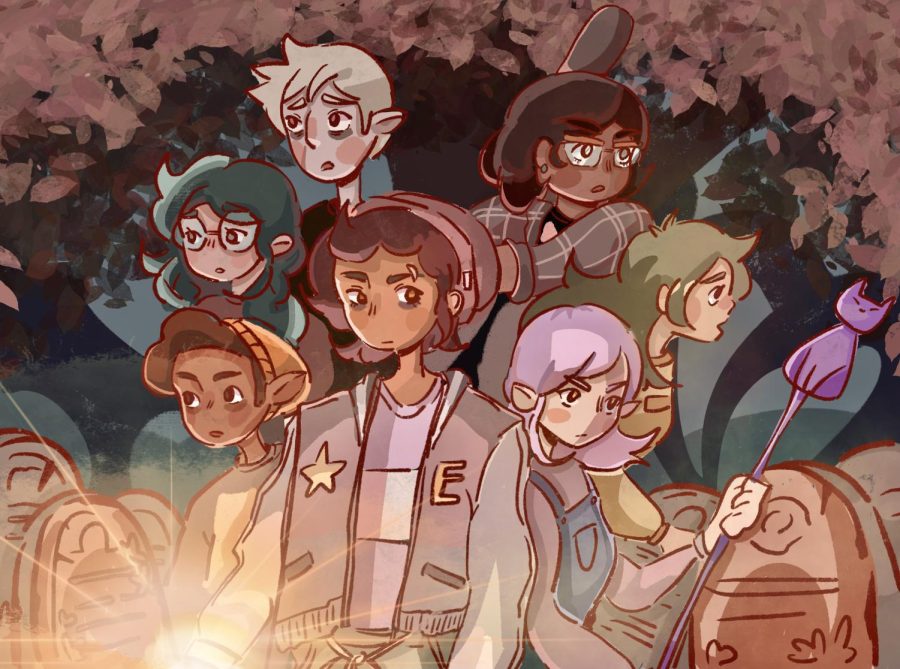Goodbye, Owl House
FIGHT OR FIGHT: Luz and her friends from Boiling Isles keep their guards up in a seemingly unwelcome forest.
May 2, 2023
It’s always bittersweet when a show ends after you spend months and years rooting for characters as they learn and grow. Fans are faced with a sense of emptiness after the show’s story becomes a thing of the past, but alas, all good things must come to an end. Most recently, the Disney animated show, “The Owl House,” joined the hall of completed legends after its last episode, “Watching and Dreaming,” aired on April 8.
Created by Dana Terrace, “The Owl House” follows a quirky teen named Luz (Sarah Nicole Robles), who stumbles upon a portal to a demon realm, otherwise known as “Boiling Isles.” In order to fulfill her long-held desire to become a witch, Luz seeks guidance from the wild witch Eda (Wendie Malick) and adorable demon warrior King (Alex Hirsch), willing to defy the odds and learn magic despite being a human. Together, the three embark on magical adventures in Boiling Isles, forming friendships and foes along the way. A perfect balance of humor and seriousness, the Disney show tackles heavy topics such as grief and loss while maintaining a positive tone.
Since the show first premiered in January 2020, “The Owl House” has blown the audience away with remarkable worldbuilding and distinct, lovable characters. Heavily inspired by the Pokemon series, viewers are lured into a colorful world of witches and glyphs. With neon glows that burst into a flurry of powers, whether it be plants, blue lights or purple blobs, every magic spell brims with creativity.
“The Owl House” is particularly notable for its LGBTQIA+ representation. With the lead character being bisexual, the first in Disney history, the show also became the first to feature same-sex couples in leading roles when Luz enters into a relationship with Amity (Mae Whitman), another witch that she meets at her magic school. Another character, Raine Whispers (Avi Roque) was also the first non-binary character in a Disney show.
Despite the show’s breakthroughs, the third season of “The Owl House” was canceled, instead being condensed into three 45 minute “specials.” Because the production team had less than three hours to wrap up the series, the storyline had to be massively readjusted. While these were drastic setbacks, the crew still rose to the challenge and tried to conclude the story as best as they could.
While cutting more than two-thirds of the intended plot may have prevented the development of major story arcs, the team instead took the hour-long formatting to their advantage by providing characters with intimate moments. Audiences will let out a collective “aww” during a scene where Luz comes out to her mother, Camilla (Elizabth Grullon) as Camilla wraps her daughter up in a loving embrace.
Aside from the heartwarming character interactions, the series of fluid animation entrances the audience as glyphs and magical flashes swirl around the Boiling Isles. The animation brings out the true extent of the magic in Boiling Isles, leaving the audience captivated, while the varying soundtrack sets the tone for each scene. As if that didn’t please fans enough, artists worked to ensure that even the tiniest details provided a glimpse into the characters’ adventures and created an easter-egg hunt for fans. In order to compensate for whatever lack of conclusion they had for the side characters, the audience is further surprised with a beautifully animated end credits scene, allowing the audience to treasure the happily-ever-after the characters deserve.
Despite the hand they were dealt, the team worked tirelessly to tie loose ends and address the relationships between characters. While they were certainly prevented from exploring more dynamics or adventures, the spectacular scenes and the tearful moments compensated for the lack of episodes. Perhaps the fact that the audience wishes for more indicates just how much the show meant to them, and how now, the show holds a special place in their hearts.


























































